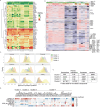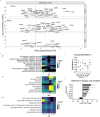Proteomics Reveals Distinctive Host Cell Protein Expression Patterns in Fed-Batch and Perfusion Cell Culture Processes
- PMID: 39834099
- PMCID: PMC11747259
- DOI: 10.1002/biot.202400567
Proteomics Reveals Distinctive Host Cell Protein Expression Patterns in Fed-Batch and Perfusion Cell Culture Processes
Abstract
Chinese hamster ovary (CHO) cells are widely used to produce recombinant proteins, including monoclonal antibodies (mAbs), through various process modes. While fed-batch (FB) processes have been the standard, a shift toward high-density perfusion processes is being driven by increased productivity, flexible facility footprints, and lower costs. Ensuring the clearance of process-related impurities, such as host cell proteins (HCPs), is crucial in biologics manufacturing. Although purification processes remove most impurities, integrated strategies are being developed to enhance clearance of some high-risk HCPs. Current understanding of HCP expression dynamics in cell culture is limited. This study utilized data-independent acquisition (DIA) proteomics to compare the proteomic profiles of cell culture supernatants from 14 FB clones and three perfusion clones, all expressing the same mAb from the same host cell line. Results showed that perfusion processes enhance cell growth and productivity, exhibiting distinct proteomic profiles compared to FB processes. Perfusion processes also maintain a more comparable HCP abundance profile across clones, especially for 46 problematic HCPs monitored. Cluster analysis of FB proteomics revealed distinct abundance patterns and correlations with process parameters. Differential abundance analysis identified significant protein differences between the two processes. This is the first extensive study characterizing HCPs expressed by clones under different process modes. Further research could lead to strategies for preventing or managing problematic HCPs in biologics manufacturing.
Keywords: fed‐batch; host cell proteins; perfusion; proteomics.
© 2025 Merck Sharp & Dohme LLC. Biotechnology Journal published by Wiley‐VCH GmbH.
Conflict of interest statement
The authors report no conflicts of interest.
Figures




References
-
- Ito T., Lutz H., Tan L., et al., “Host Cell Proteins in Monoclonal Antibody Processing: Control, Detection, and Removal,” Biotechnology Progress 40 (2024): e3448. - PubMed
-
- Botelho Ferreira K., Benlegrimet A., Diane G., et al., “Transfer of Continuous Manufacturing Process Principles for mAb Production in a GMP Environment: A Step in the Transition From Batch to Continuous,” Biotechnology Progress 38, no. 4 (2022): e3259. - PubMed
-
- Arnold L., Lee K., Rucker‐Pezzini J., and Lee J. H., “Implementation of Fully Integrated Continuous Antibody Processing: Effects on Productivity and COGm,” Biotechnology Journal 14, no. 2 (2019): 1800061. - PubMed
-
- Rodriguez J., Spearman M., Tharmalingam T., et al., “High Productivity of Human Recombinant Beta‐Interferon From a Low‐Temperature Perfusion Culture,” Journal of Biotechnology 150, no. 4 (2010): 509–518. - PubMed
MeSH terms
Substances
LinkOut - more resources
Full Text Sources
Miscellaneous

